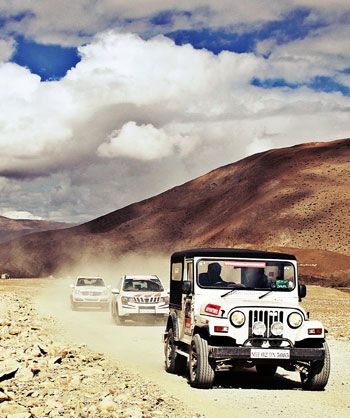
To gaze upon Mount Everest and not have the tectonic plates of one's inner core shift is an impossible task in a human being, says Saisuresh Sivaswamy/Rediff.com after a road trip to the 5,200-metre Everest Base Camp.
What does one do when one day, out of the blue, one is told to go on a road trip to the Everest Base Camp?
Not just any road trip -- which ordinarily would mean leisurely drive along highways -- but one organised by Mahindra Adventure, which involves offroading in the Himalayan heights but also reaching the 17,000 feet height in just four days, with no time to acclimatise etc?
The Summit, as this trip was called, was a challenge both for the company as well as the participants, for neither had done it before. For Mahindra Adventure, which since 2011 has been organising around 30 trips every year, with at least 10 being multi-day expeditions, going to the base camp was the logical followup to similar ones like Monastery Escape, Desert Storm and Tri-Nation Escape.
But the Summit Drive, with its tagline of 'Get Lost', was a different kind of challenge, in that it involved driving through China (Tibet) to reach the North Base Camp (the South Base Camp is in Nepal).
To overcome the logistical issues, the drive was partnered with the Kathmandu-based Sacred Summits, whose Rabi Thapa was part of the expedition to the base camp, providing valuable feedback as well as guidance on the ground through unfamiliar territory.
"The key objective behind Mahindra Adventure is to cement the tough and rugged DNA of Mahindra products," offers manager K S Venkatesh by way of explanation as to why the company does this, adding, "The Summit Drive is one such initiative which is all about scaling new heights and achieving things that haven't been done by anyone before."
Before throwing open the Summit Drive to the public, the company took along a small group of journalists to the base camp, as sort of willing guinea pigs. After all, who doesn't love a good dose of adventure, especially when it comes packaged in sturdy strong automobiles and in an exotic land!
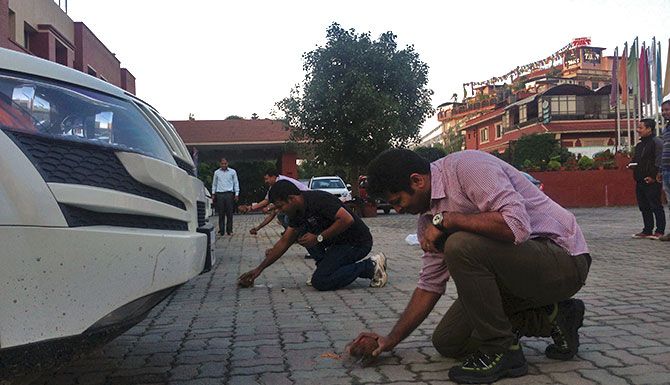
Day 1
At roughly 8 am local time in Tibet on a Friday, as I trudged the final 50 feet up a hillock from where a clear, uninterrupted view of Mount Everest can be had in all its sun-basked glory, it seemed for a moment that the heart would give up.
And it was not just at the excitement of ascending 17,000 feet for the date with the eternal beauty.
It was not just age -- at almost 50, I was the oldest in our group making it up the hillock at various speeds --- that was issuing me a gentle reminder of the physical toll the last few days had taken.
It was not just the sub-zero temperature that I was battling, wrapped up as I was unrecognisably in swaddles of warm clothing that only plains folk can appreciate, the bone-chilling cold telling me gently that this was not Juhu beach, you know, where you can step out for a stroll.
Indeed it was all this, and then some.
For to gaze upon Mount Everest, or Qomolangma to give its Tibetan name (or Sagarmatha in Nepali/Sanskrit), and not have the tectonic plates of one's inner core shift, is an impossible task in a human being.
And I was not the only one to feel that way. Among the tens of trekkers of various nationalities thronging the hillock that early October morning, the feeling was one of awe. Of coming face to face with the absolute and eternal. It took everyone a few minutes to gather one's wits, to speak the normal.
Which, in this case, was mostly, 'Excuse me, can you take my photograph?'
I looked at my group, which had forged a sense of bonding and oneness over the last few days, and wondered if they felt the same way as I did.
'Awesome' somehow seemed too banal a description of what we felt in that electric moment.
Slowly, as we internalised our feelings and returned to the rugged Mahindra SUVs that had brought us this far from Kathmandu on its Summit Drive, the events of the last few days came rushing through.

For Mahindra Adventure, a section of the Indian auto major, which had forged this climb to the base camp for the first time for an Indian company, summiting and offroading were a natural corollary to their fleet of outdoorsy vehicles.
The lithe Thar, of which we had two in our group, is to the offroad born, the ultimate symbol of outdoor machismo that can chew and spit out the worst of the roads.
The muscular XUV, with its plush interiors and rugged exteriors, meets every challenge on the road with nary a discomfort to its occupants.
And the Rexton, which joined the Mahindra stable after its takeover of the Korean major Ssangyong, packs a mean punch, especially on level surfaces.
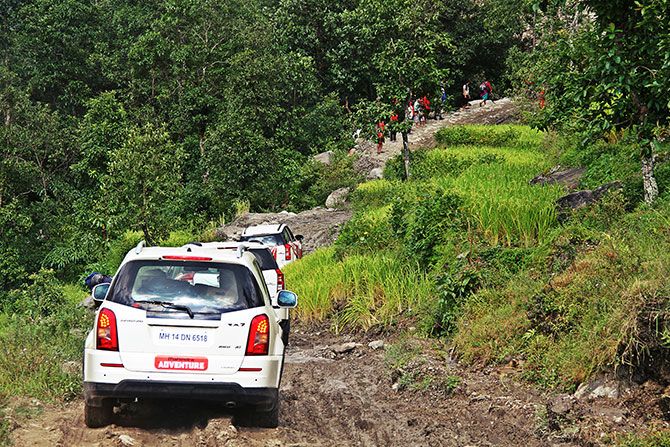
The five vehicles had set out in convoy five days earlier from Kathmandu, to go where no Indian vehicle has gone before, to the Everest Base Camp in Tibet. Going along for the first time on such a trip -- the others in the group were inveterate motoring buffs plus journos -- one realises the enormous amount of logistical preparation and planning that go into a trans-border drive as this one.
What if the vehicles were to break down/have a flat tyre/run out of fuel? Thus we were prepared for any unforeseen eventuality -- the convoy had a service expert who knew just what had to be done.
Again, driving into Tibet, part of China, for a group of Indians is not going to be the easiest thing to do. So the wheels had been set in motion days earlier, permits applied and secured, a local guide who could work through regional officialdom was hired.
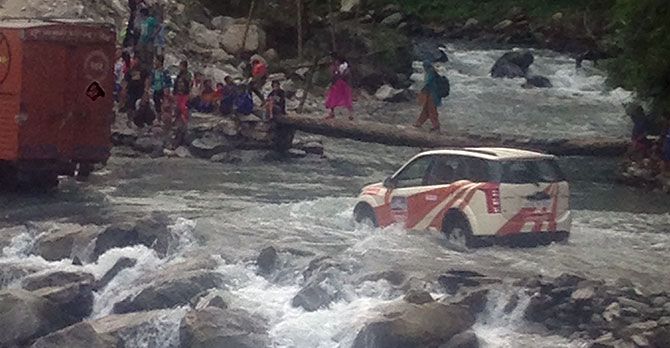
But there could always be force majeur, that clause so beloved of legal eagles, as we were to discover on the drive towards the Nepal-China border.
When we set out from our Kathmandu hotel in five SUVs -- two XUVs, two Thars and one Rexton -- the intent was to cross into China by the first evening, and halt at the border post of Zhangmu. And things seemed to go according to plan, despite the Dasain holiday crowd heading out of the city, when we pulled up for a thoughtfully-packed breakfast a couple of hours later.
From then on the drive was smooth, the road uphill into the Himalayas holding fine. The rude jolt came at Jurey, where a huge landslide had converted a river into a lake and swallowed up the road.
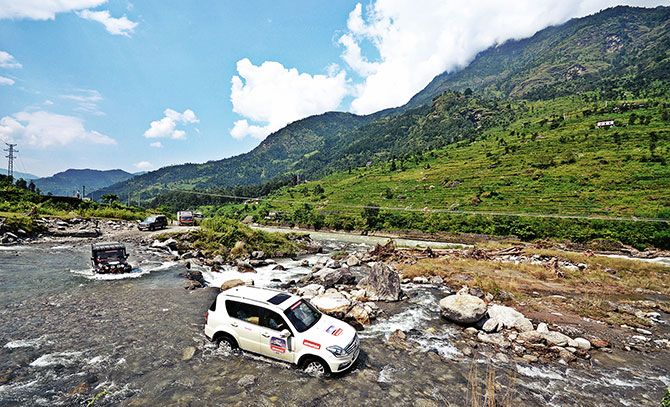
This meant a huge traffic pileup, leaving the convoy with no option but the one it had come expecting and prepared for: Go off road, and cross the river when you come to it.
The offroad lasted a few kilometres, and is where the Mahindra vehicles came into their own. While the Rexton, otherwise a beast on the road, struggled in the upward inclines, the XUVs and Thars made short work of the non-existent road, even sailing smoothly across the river crossing where the water reached bonnet level. How bad was the water? Enough to halt a truck midstream.
From then to the Nepali border town of Tattopani (or Kasha, as it is known on the Chinese side), was a question of perseverance and endurance on bad, serpentine mountain roads.
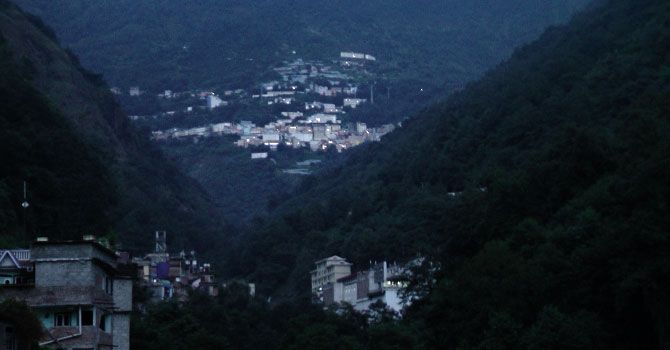
We reached Tattopani, known for its hot springs and for Last Resort, which boasts of the world's highest bungee jumping point, at 3 pm local time, expecting to make it past the Chinese border, but the times were against us.
Specifically, time was against us. Across the border, some 100 metres away, it was already 5.30 pm and the immigration counters had closed for the day, we were told. Forcing us to stay put in the cold, damp town on the banks of the scenic Bhote Kosi river.
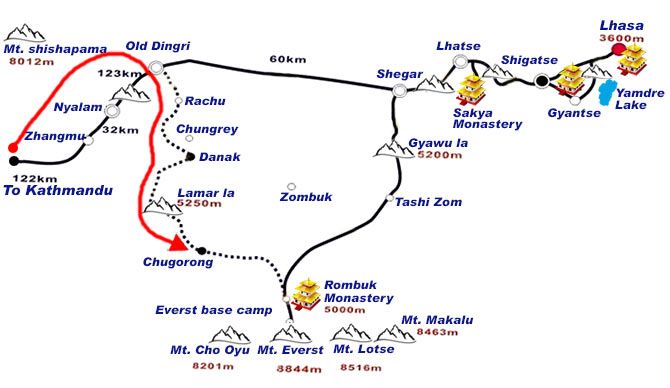
The contrast between the two sides, we could see in the evening, was stark. While the Nepal side was dark with little or no electricity, the Chinese side dazzled the night away with its bright lights.
Distance covered: 300 km; Time taken: 8 hours; Altitude: 1,200 metres (little lower in elevation than Dharmshala, Himachal Pradesh). Clothing: Light sweater, and for the evening a scarf and hat.
Day 2 Here's crossing into Tibet
Day 3 The world's highest post office
Day 4 An eyeful of Everest










